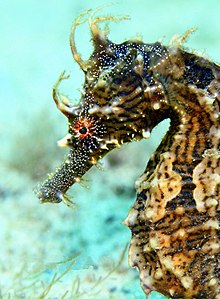| Lined seahorse | |
|---|---|

| |
| Scientific classification | |
| Domain: | Eukaryota |
| Kingdom: | Animalia |
| Phylum: | Chordata |
| Class: | Actinopterygii |
| Order: | Syngnathiformes |
| Family: | Syngnathidae |
| Genus: | Hippocampus |
| Species: | H. erectus
|
| Binomial name | |
| Hippocampus erectus Perry, 1810
| |
| Synonyms[3] | |
| |
The lined seahorse (Hippocampus erectus), northern seahorse or spotted seahorse, is a species of fish that belongs to the family Syngnathidae.[3][4] H. erectus is a diurnal species with an approximate length of 15 cm (5.9 inches) and lifespan of one to four years. The H. erectus species can be found in myriad colors, from greys and blacks to reds, greens, and oranges. The lined seahorse lives in the western Atlantic Ocean as far north as Canada and as far south as the Caribbean, Mexico, and Venezuela. It swims in an erect position and uses its dorsal and pectoral fins for guidance while swimming.
Lined seahorses feed mainly on minute crustaceans and brine shrimp, which they suck in through their snout. They are able to suck their prey by creating a current of water leading directly into its snout. Since seahorses are weak swimmers, they must ambush their prey by blending into their surroundings, which they do rather easily. The lined seahorse's eyes can move independently of one another, allowing it to effectively scan its surroundings. The species is sexually dimorphic and it is easy to distinguish between a male and female lined seahorse. The males are larger and also have longer tails. The lined seahorse is monogamous and performs ritual dances every morning to reestablish the bond with its mate. In addition, they create clicking sounds while embracing their partner. This action occurs when they initially find their mate. The intensity of their bond is also conveyed in how they handle the death of their partner: If either the male or female should die, the mate does not automatically replace the deceased mate with a new one. Often, it fails to find a new mate in its short lifespan.
Like with other seahorses, the male lined seahorse is the caregiver. During intercourse, the female sprays her eggs into the male's brood pouch where the eggs will incubate for 20–21 days. When the juveniles are ready to hatch, the male attaches its tail to a stationary structure and begins to arch its back, back and forth, releasing the juveniles into the water column. The juveniles are approximately 11 mm at birth. They quickly begin to learn and mimic the behavior of its parent. Courtship between the male and female parents begins immediately after birth.
The habitat of the lined seahorse is diminishing due to coastal growth and pollution, which ultimately is the cause of the decreasing population. The lined seahorse is also used as Chinese medicine and is common in the aquarium trade, contributing to its "vulnerable" status.
- ^ Pollom, R. (2017). "Hippocampus erectus". IUCN Red List of Threatened Species. 2017: e.T10066A20191442. doi:10.2305/IUCN.UK.2017-3.RLTS.T10066A20191442.en. Retrieved 19 November 2021.
- ^ "Appendices | CITES". cites.org. Retrieved 2022-01-14.
- ^ a b Froese, R.; Pauly, D. "Hippocampus erectus Perry, 1810 Lined Seahorse". FishBase.
- ^ Scales, Helen (2009). Poseidon's Steed: The Story of Seahorses, From Myth to Reality. Penguin Publishing Group. p. 136. ISBN 978-1-101-13376-7. Retrieved 9 June 2019.
